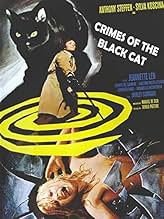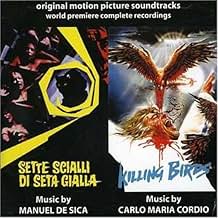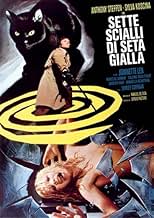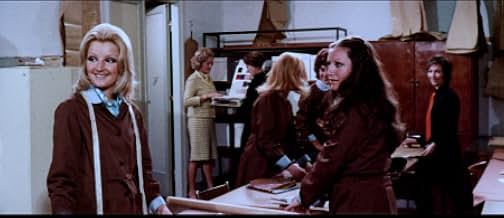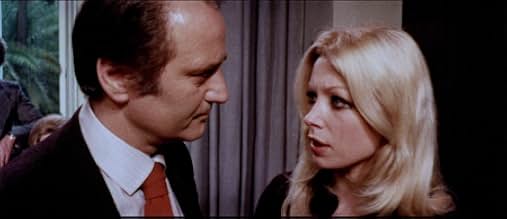IMDb-BEWERTUNG
6,1/10
1121
IHRE BEWERTUNG
Füge eine Handlung in deiner Sprache hinzuA blind pianist overhears a conversation in a nightclub, and is determined to figure out who is responsible for a string of strange murders involving a black cat.A blind pianist overhears a conversation in a nightclub, and is determined to figure out who is responsible for a string of strange murders involving a black cat.A blind pianist overhears a conversation in a nightclub, and is determined to figure out who is responsible for a string of strange murders involving a black cat.
Giovanna Lenzi
- Susan Leclerc
- (as Jeannette Len)
Isabelle Marchall
- Paola Whitney
- (as Isabelle Marchal)
Lorenzo Piani
- Waiter in Hamburg
- (Nur genannt)
Bruno Alias
- Hairdresser
- (Nicht genannt)
Francesco Anniballi
- Male Nurse
- (Nicht genannt)
Florinda Bolkan
- Carol Hammond
- (Archivfilmmaterial)
- (Nicht genannt)
Margherita Horowitz
- Atelier personnel
- (Nicht genannt)
Empfohlene Bewertungen
The Crimes of the Black Cat is a pretty typical Giallo, which takes influence from many of the more established genre classics. The central character is blind, which is an idea lifted from Argento's 'The Cat o'Nine Tails', and the style and plotting is clearly reminiscent of Argento's early work. The black cat is an animal often seen in horror films, and that's down to Edgar Allen Poe and his famous story about the ominous animal. The way that the cat is used in this film is good because it's instrumental to the plot (unlike other Giallo's which mention a cat in the title and barely even feature one), but it really has to be said that the modus operandi used by the murderer is completely ridiculous even for a Giallo. The plot focuses on Peter Oliver; a blind, yet rich man who finds himself at the centre of a murder investigation when his girlfriend is killed. It seems that someone has a grudge against some of the local fashion models, and all the murders have the common theme of a yellow shawl being found next to the dead victims. But how do you catch a murderer that you cannot see?
Director Sergio Pastore, while taking many themes from across the Giallo genre, hasn't decided to make the film as bloody as some of its counterparts. The murder weapon doesn't allow for too much of the red stuff, but even so; it comes as a huge shock at the end when this placid film explodes with a Psycho-style shower sequence that features some of the most disgusting gore in the entire Giallo genre; and almost makes up for the lack of blood in the rest of the film. There is a lot of sleaze in the movie, however, and this is shown through ideas such as lesbianism and drug use; and that in turns blends well with the depressing urban climate in which the movie takes place. The acting is nothing special, but it's not bad in Giallo terms. Antonio De Teffè does well in the lead role and succeeds at convincing us he is actually blind. There are no real stars in the film beside him, and the lack of a heroine doesn't do the film too many favours either. Overall, this is a rather strange entry in the Giallo cycle as it has a number of good and inventive moments; but it's all encased around a lot of borrowing and tributes. Still, i wouldn't hesitate to rate this film as a success and it comes recommended to Giallo fans!
Director Sergio Pastore, while taking many themes from across the Giallo genre, hasn't decided to make the film as bloody as some of its counterparts. The murder weapon doesn't allow for too much of the red stuff, but even so; it comes as a huge shock at the end when this placid film explodes with a Psycho-style shower sequence that features some of the most disgusting gore in the entire Giallo genre; and almost makes up for the lack of blood in the rest of the film. There is a lot of sleaze in the movie, however, and this is shown through ideas such as lesbianism and drug use; and that in turns blends well with the depressing urban climate in which the movie takes place. The acting is nothing special, but it's not bad in Giallo terms. Antonio De Teffè does well in the lead role and succeeds at convincing us he is actually blind. There are no real stars in the film beside him, and the lack of a heroine doesn't do the film too many favours either. Overall, this is a rather strange entry in the Giallo cycle as it has a number of good and inventive moments; but it's all encased around a lot of borrowing and tributes. Still, i wouldn't hesitate to rate this film as a success and it comes recommended to Giallo fans!
One thing you can say about Italian gialli: they never resort to killing someone with a simple shooting or stabbing--the villains always use some ridiculously elaborate Rube Goldberg method for doing their victims in. And this giallo features what might be the most ridiculous of them all. I don't want to give too much away, but I will say that the English title "Crimes of the Black Cat" can be taken completely literally. (Obviously, the people who thought up this movie were not cat owners--have you ever tried to get a cat to do ANYTHING?). Aside from the especially absurd murders this is a typical giallo. It is set in the European fashion world, it's highly stylized, the plot makes little sense, and the motivation of the villain turns out to be even more ludicrous than the method of murder.
The protagonist is the blind male lover of the first murder victim. (How come blind people never complain that they are always being stereotyped as good-looking and resourceful individuals who always get to solve the crime and sleep with many attractive members of the opposite sex along the way?). The only name star is Sylva Koscina, but she is barely in the movie. The best actor though is the cat (perhaps the self-same feline thespian who played "Satan" in "Gently, Before She Dies"). After he exits the film, it quickly spirals downward with a truly tasteless shower murder and one of those abrupt freeze-frame endings that were so big in the 70's (maybe they ran out of film a lot back then). If you like gialli at all though, you'll probably like this one. It's very typical for its kind.
The protagonist is the blind male lover of the first murder victim. (How come blind people never complain that they are always being stereotyped as good-looking and resourceful individuals who always get to solve the crime and sleep with many attractive members of the opposite sex along the way?). The only name star is Sylva Koscina, but she is barely in the movie. The best actor though is the cat (perhaps the self-same feline thespian who played "Satan" in "Gently, Before She Dies"). After he exits the film, it quickly spirals downward with a truly tasteless shower murder and one of those abrupt freeze-frame endings that were so big in the 70's (maybe they ran out of film a lot back then). If you like gialli at all though, you'll probably like this one. It's very typical for its kind.
De Sica's below-average score notwithstanding (and they do count a lot in these movies, don't they?) this is a satisfying giallo with all the key elements included and none of them bungled. Granted, a lot of those key elements are ripped right from other movies, and the direct influence of Psycho, Black Belly of the Tarantula, Blood and Black Lace, Lizard in a Woman's Skin and most of all Cat O'Nine Tails doesn't win it points for creativity, but it's all handled as though it were the first film ever made so you don't really mind. The plot, with its typically and gloriously dumb motive for the killings (in this case a car crash in the past, as was the case with Seven Orchids Stained in Blood) moves along at a fair pace, and making the hero blind gives him a sympathetic attraction most giallo heroes lack. It's not as good as any of the films from which it's descended but nevertheless a solid entry in the genre.
The first half of this giallo is fairly undistinguished, especially since it blatantly copies Mario Bava (the fashion-house setting being lifted, yet again, from BLOOD AND BLACK LACE [1964]) and Dario Argento (borrowing its blind hero-turned-sleuth from THE CAT O'NINE TAILS [1971]). However, the film is stylish enough (particularly the zoom-happy murder sequences) and the plot convoluted enough (taking in a plethora of shady characters invariably involved in adultery, drug-taking, blackmail and revenge) to overcome its basic lack of originality; the circus-world back-story, then, should perhaps excuse its uniquely far-fetched murder method...though the seven yellow-silk shawls referred to in the original Italian title are equally insignificant!
The film's pulsating score by Manuel De Sica (son of neo-realist master film-maker and versatile actor Vittorio De Sica) is serviceable but unremarkable, as is the cast led by Anthony Steffen, Sylva Koscina (in what at first appears to be merely an extended cameo) and Giacomo Rossi-Stuart. Its use of nudity is very discreet (though it doesn't appear that any cutting was done, I haven't been able to establish the film's correct running time; the print I watched was around 94 mins. in PAL format, but some sources list versions running as long as 108 mins.!) and the gore only truly surfaces at the very end (with a particularly nasty shower murder, shamelessly ripping off Hitchcock's PSYCHO [1960] - but remaining, for my money, one of the genre's most memorable set-pieces). After the mystery has supposedly been solved (and the revelation of the killer's identity having thus proved quite lame and lazy, in my opinion), the film manages to pull the rug from under our feet - so much so that I had to watch the ending twice! - by providing one final twist. By the way, the decision to conclude the film in mid-sequence on a freeze-frame is another Argento influence, namely FOUR FLIES ON GREY VELVET (1971)!
All in all, a giallo more interesting in its borrowings than for any individual achievements - but one that remains eminently watchable just the same.
The film's pulsating score by Manuel De Sica (son of neo-realist master film-maker and versatile actor Vittorio De Sica) is serviceable but unremarkable, as is the cast led by Anthony Steffen, Sylva Koscina (in what at first appears to be merely an extended cameo) and Giacomo Rossi-Stuart. Its use of nudity is very discreet (though it doesn't appear that any cutting was done, I haven't been able to establish the film's correct running time; the print I watched was around 94 mins. in PAL format, but some sources list versions running as long as 108 mins.!) and the gore only truly surfaces at the very end (with a particularly nasty shower murder, shamelessly ripping off Hitchcock's PSYCHO [1960] - but remaining, for my money, one of the genre's most memorable set-pieces). After the mystery has supposedly been solved (and the revelation of the killer's identity having thus proved quite lame and lazy, in my opinion), the film manages to pull the rug from under our feet - so much so that I had to watch the ending twice! - by providing one final twist. By the way, the decision to conclude the film in mid-sequence on a freeze-frame is another Argento influence, namely FOUR FLIES ON GREY VELVET (1971)!
All in all, a giallo more interesting in its borrowings than for any individual achievements - but one that remains eminently watchable just the same.
"Sette scialli di seta gialla" (Crimes of the black cat) takes place in Copenhagen. The grey subdued skies of Copenhagen and the meditative soundtrack of Manuel de Sica, are a preparation for the giallo we are about to see - a blind pianist, Peter Oliver (Anthony Steffen) investigating a string of murders of fashion models.
Paola Whitney (Isabelle Marchal), Peter Oliver's girlfriend, is murdered, and the police, the other models no one knows exactly what happened and the reason why it happened. She was alone in her room in the fashion house, and then suddenly
Peter Oliver suspects that one of the reasons may be blackmail (fragments of a strange conversation overheard in a bar led him to this conclusion), but nothing really seems to explain the mystery. So Peter Oliver, with the help of his butler Burton (Umberto Raho) and beautiful Margot (Shirley Corrigan) - secretary of Françoise Ballais (Sylva Koscina), owner of the fashion house - , decides to investigate on his own the death of Paola. Other murders happen, the killer seems to anticipate each step of Peter, and there are other developments. As to the police, Inspector Jansen (Renato de Carmine) learns to respect the deductive powers of Peter. Sometimes the case seems about to be solved, but
Besides the characters already mentioned, there are, of course, many gorgeous fashion models (some about to be sacrificed), there's Victor Morgan (Giacomo Rossi-Stuart) that is, so to say, married to Françoise Ballais, and has already experienced troubled waters, and there's also a mysterious junkie woman (Giovanna Lenzi), an important piece in this chess game, and we should not forget the reviled black cat, a very important tool, always followed by a yellow shawl!.
In spite of its many curves, the story is not as convoluted as it seems, and there's one scene in particular that may please gorehounds.
Anthony Steffen, as the blind pianist, demonstrates again his talent and screen charisma and Giovanna Lenzi, as the junkie woman, is another highlight of the film (and the black cat too, of course!).
"Crimes of the black cat" has the visual beauty and style usual in many gialli, the editing is smooth and the film is pleasant to see – feminine beauty peppered with some thrills and violence. Sergio Pastore pays homages to Bava, Argento and... (surprise!), but the film has its own world and atmosphere.
Paola Whitney (Isabelle Marchal), Peter Oliver's girlfriend, is murdered, and the police, the other models no one knows exactly what happened and the reason why it happened. She was alone in her room in the fashion house, and then suddenly
Peter Oliver suspects that one of the reasons may be blackmail (fragments of a strange conversation overheard in a bar led him to this conclusion), but nothing really seems to explain the mystery. So Peter Oliver, with the help of his butler Burton (Umberto Raho) and beautiful Margot (Shirley Corrigan) - secretary of Françoise Ballais (Sylva Koscina), owner of the fashion house - , decides to investigate on his own the death of Paola. Other murders happen, the killer seems to anticipate each step of Peter, and there are other developments. As to the police, Inspector Jansen (Renato de Carmine) learns to respect the deductive powers of Peter. Sometimes the case seems about to be solved, but
Besides the characters already mentioned, there are, of course, many gorgeous fashion models (some about to be sacrificed), there's Victor Morgan (Giacomo Rossi-Stuart) that is, so to say, married to Françoise Ballais, and has already experienced troubled waters, and there's also a mysterious junkie woman (Giovanna Lenzi), an important piece in this chess game, and we should not forget the reviled black cat, a very important tool, always followed by a yellow shawl!.
In spite of its many curves, the story is not as convoluted as it seems, and there's one scene in particular that may please gorehounds.
Anthony Steffen, as the blind pianist, demonstrates again his talent and screen charisma and Giovanna Lenzi, as the junkie woman, is another highlight of the film (and the black cat too, of course!).
"Crimes of the black cat" has the visual beauty and style usual in many gialli, the editing is smooth and the film is pleasant to see – feminine beauty peppered with some thrills and violence. Sergio Pastore pays homages to Bava, Argento and... (surprise!), but the film has its own world and atmosphere.
Wusstest du schon
- WissenswertesAnthony Steffen was dubbed by Edmund Purdom for the English language version.
- PatzerAfter the cat lady's death, the newspaper headline misspells "mystery", as in "The mistery (sic) of the black cat still goes on."
- VerbindungenFeatures Una lucertola con la pelle di donna (1971)
Top-Auswahl
Melde dich zum Bewerten an und greife auf die Watchlist für personalisierte Empfehlungen zu.
- How long is The Crimes of the Black Cat?Powered by Alexa
Details
- Erscheinungsdatum
- Herkunftsland
- Sprache
- Auch bekannt als
- The Crimes of the Black Cat
- Drehorte
- Kopenhagen, Dänemark(location)
- Produktionsfirmen
- Weitere beteiligte Unternehmen bei IMDbPro anzeigen
- Laufzeit1 Stunde 39 Minuten
- Sound-Mix
- Seitenverhältnis
- 2.35 : 1
Zu dieser Seite beitragen
Bearbeitung vorschlagen oder fehlenden Inhalt hinzufügen

Oberste Lücke
By what name was Sette scialli di seta gialla (1972) officially released in India in English?
Antwort
